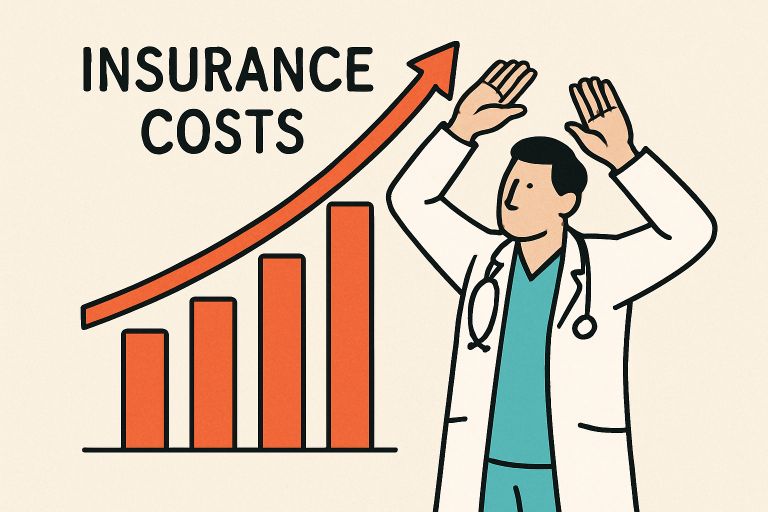Key Takeaways:
- Healthcare providers are facing escalating excess loss coverage costs due to factors like increased claim severity and higher medical expenses.
- Implementing self-insurance models, such as captive insurance, can offer more control over coverage and costs.
- Utilizing predictive analytics and AI can help identify high-cost claimants and manage risks proactively.
- Collaborating with other organizations through group captives can spread risk and reduce individual exposure.
- Regularly reviewing and adjusting coverage limits and deductibles can align insurance strategies with current financial capabilities.
Understanding the Surge in Excess Loss Coverage Costs
Healthcare organizations across the United States are encountering significant increases in their insurance expenditure, particularly in excess loss coverage. Driven by mounting claim severity, complex care needs, and inflationary pressures on medical costs, these rising insurance premiums can substantially impact a provider’s financial stability. Among the top concerns, provider excess loss insurance stands out as a critical tool for safeguarding against catastrophic or unpredictable claims that exceed predetermined limits. Navigating these surging costs has become a top priority for healthcare leaders seeking to maintain sustainable operations.
Recent data indicate that U.S. medical liability premiums surpassed $11.6 billion in 2023, marking one of the industry’s highest periods for insurance payouts. The sharp increase is driven by both advancements in treatments and an uptick in high-dollar claims, making cost containment more challenging for providers of all sizes. Adapting to this environment requires strategic planning and innovative solutions tailored to the modern healthcare landscape. Healthcare finance executives must evaluate which approaches best suit their organizations, striking a balance between comprehensive risk protection and budget-friendly measures.
The ability to control and predict insurance costs is more challenging than ever in the current healthcare market. Rising patient expectations and regulatory changes further complicate the picture, requiring agile responses and a willingness to adopt new tools for risk evaluation. Health systems that invest in proactive risk management and cost-containment measures are more likely to weather the volatility and protect their long-term fiscal health.
Critical to controlling excess loss costs is understanding the confluence of factors driving price increases and identifying actionable strategies that can deliver measurable savings. Leading organizations leverage in-depth data analysis and collaborate across industry networks to stay ahead of insurance trends. As excess loss coverage expenses continue to rise, adopting a diversified and flexible approach is crucial for success.
Embracing Captive Insurance for Cost Control
Captive insurance is emerging as a powerful tool for healthcare providers seeking greater control over their risk management and insurance expenses. Through captive structures, organizations form their own insurance subsidiaries, which allows for more tailored coverage, enhanced oversight of claims management, and potential long-term savings. According to Modern Healthcare, the Patient Protection and Affordable Care Act has increased the interest of middle-market employers in captives to fund medical stop-loss coverage for their self-funded health benefit plans.
The benefits of captive insurance extend beyond cost savings. Providers can customize policies to fit their unique risk profiles, retain underwriting profits, and access reinsurance markets previously closed to them. Additionally, captives foster a stronger culture of risk management within organizations, as stakeholders become directly invested in claims administration and loss prevention. This alignment of incentives often leads to more efficient claims handling and robust mitigation strategies.
Leveraging Predictive Analytics and Artificial Intelligence
Healthcare providers have unprecedented access to data, and advanced analytics tools are transforming how organizations forecast and manage insurance risks. By using predictive analytics and artificial intelligence (AI), healthcare leaders can identify patients most likely to incur high-cost claims, enabling earlier intervention and cost mitigation. For example, a study based on health insurance claims from nearly 48 million individuals demonstrated that AI models could predict very high-cost claimants with over 91% accuracy, highlighting the value of technology in supporting insurance strategy. AI-driven insights are enabling more precise underwriting decisions and tailored interventions to reduce the incidence and severity of catastrophic claims.
Participating in Group Captives
Smaller and mid-sized healthcare organizations often lack the necessary scale to implement standalone insurance solutions. Group captives provide a collaborative alternative, enabling like-minded entities to pool their risks and resources. By joining a group captive, participants share the costs and benefits of self-insurance, gain improved negotiating leverage with insurance markets, and can directly benefit from underwriting profits. Group captives foster an environment of transparency and shared best practices, helping members collectively reduce insurance expenses while managing risk effectively.
Regular Review of Coverage Limits and Deductibles
A proactive review of coverage limits and deductibles is essential for maintaining a sustainable insurance strategy. Healthcare providers should routinely assess current risk tolerance, claims history, and financial capacity to determine if their insurance portfolio still aligns with organizational goals. Adjusting limits or increasing deductibles can decrease premium outlay but requires disciplined financial planning to ensure the organization can absorb greater risk. An agile approach to re-evaluating and updating insurance structures helps maintain budgetary equilibrium and ensures protection remains sufficient as market conditions shift.
Implementing Cost-Effective Care Management Programs
Prevention is at the heart of reducing high-cost claims. Healthcare systems investing in comprehensive care management programs—especially those targeting chronic disease, preventive screenings, and patient education—are seeing measurable reductions in catastrophic claim events. Initiatives that focus on early intervention, care coordination, and patient engagement drive long-term savings not only in direct healthcare expenditure but also in the cost of excess loss coverage. By reducing claim frequency and severity, robust care management can serve as a foundational element of a holistic insurance strategy.
Enhancing Patient Payment Experiences
Improving the patient payment process remains a crucial, often-overlooked factor in overall insurance and revenue cycle health. Offering transparent and accurate pre-treatment cost estimates can build trust and facilitate timely payments, addressing a significant gap in customer satisfaction. According to a survey, nearly 90% of patients want accurate estimates before care, but fewer than a third currently receive them. Optimizing the payment experience helps reduce patient attrition, diminish collections costs, and stabilize income flow for providers.
Conclusion
Rising excess loss coverage costs necessitate that healthcare providers adopt forward-thinking risk management strategies. By implementing captive insurance structures, investing in predictive analytics and AI, participating in group captives, and enhancing care management and payment experiences, organizations can mitigate insurance cost volatility while protecting their financial well-being. Embracing a multifaceted approach allows healthcare leaders to withstand market pressures and deliver consistent, high-quality care in a challenging insurance environment.



